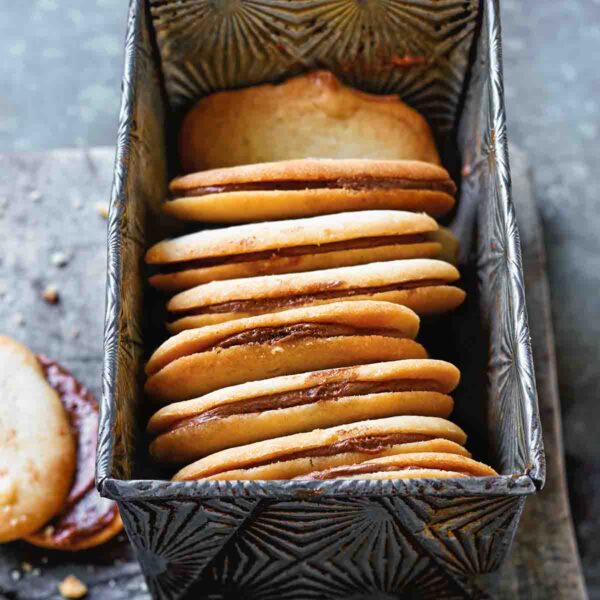
TL;DR (Quick-Answer Box)
- What it is: A homemade, sophisticated version of the classic Pepperidge Farm cookie: delicate, buttery biscuits sandwiched with a rich, velvety whipped hot fudge filling.
- Why you’ll love it: These cookies are irresistibly light, perfectly crisp, and feature a deeply chocolatey, scratch-made ganache that makes them superior to the store-bought box.
- How to make it: Pipe the butter cookie dough into strips + refrigerate until firm. Bake until the edges are golden brown and the tops are firm, 14 to 16 minutes. Sandwich the cooled wafers with a smooth, whipped fudge filling.

Jump To
Let’s be honest, these cookies are incredibly good and it’s pretty hard to stop at just one. Which is why they hold a permanent position on our list of best Valentine’s cookies.
Why bother making them from scratch, you ask? Won’t homemade Milano cookies take longer than a jaunt to the store for a bag of Pepperidge Farm that you rip open the second you get into the car? Why yes, it will. But where’s the satisfaction in that? Where’s the pride? Where’s the strangely soothing longing that comes with prolonged anticipation? Where’s the loveliness that comes with a perfectly imperfect homemade touch?
Because seriously, folks, the Pepperidge Farm Milano cookies simply can’t compete with these magnificently lovely homemade Milano cookies. They’re so excellent we actually named the book in which the recipe is found one of our favorite cookbooks of the year.
Chow,

Homemade Milano Cookies FAQs
Milano cookies are, in case you’re somehow unfamiliar with the marvel of mid-century American processed foods, “those European vanilla cookies sandwiched together with chocolate from the folks at Pepperidge Farm,” explain the authors of this recipe. [Editor’s Note: Our friends in Canada will know these as Monaco cookies.]
Here we call on LC Tester extraordinaire, Larry Noak, “You absolutely do not need the Ateco pastry tip, which even in a town the size of Atlanta was impossible to find. I used a disposable Walton pastry bag with no tip. The key is to hold the opening of the pastry bag on the parchment as you move it to keep the cookies thin. I found it far simpler to pipe 3 continuous lines, rounding the ends at the beginning and end with a short segment in the middle as the second stroke. It may take a bit of practice but your technique will improve with each cookie.”
Actually, we suggest that you make the fudge filling ahead of time, at least a day in advance. You’ll find it easier to use once it’s had some time to firm up. There won’t be as much oozing when you try to sandwich the biscuits together with a firmer fudge.

Homemade Milano Cookies
Equipment
- Ateco tip #895 for piping the cookies and filling them with hot fudge
Ingredients
- 2 sticks unsalted butter, at room temperature
- 1 cup confectioners’ sugar, sifted
- 1/3 cup granulated sugar
- 1/2 cup whole milk, at room temperature
- 1 tablespoon vanilla extract
- 2 1/2 cups unbleached all-purpose flour, sifted
- 1 teaspoon kosher salt
- 1 1/2 cups Hot Fudge, (we suggest making this the day before and refrigerating it overnight)
Instructions
- In the bowl of a stand mixer fitted with the paddle attachment, beat the butter on medium speed for 5 to 10 seconds. Add the sugars and mix on low speed just until incorporated. Increase the speed to medium and beat the butter mixture until it's aerated (that means fluffy) and looks like frosting, 2 to 3 minutes. Scrape the sides and bottom of the bowl with a rubber spatula to everything together.
- Pour the milk and vanilla in a liquid measuring cup. In a bowl, whisk together the flour and salt.
- Add the milk and vanilla to the butter mixture in the bowl and mix on medium speed for 45 seconds to 1 minute, or until nearly completely incorporated.
- Add the flour mixture to the bowl all at once and mix on low speed until everything just comes together, approximately 30 seconds. Scrape down the sides and mix for another 30 seconds to a minute to ensure the batter is homogeneous. Remove the bowl from the stand mixer. With a plastic bench scraper, bring the batter completely together by hand.
- Fit a pastry bag with the Ateco tip #895 and fill it with the cookie batter.
- The most challenging part of making these cookies is piping the batter so that the cookies are the same size. To make it easier, fold sheets of parchment paper into thirds like a business letter, using the folds as a template for piping. (For this recipe, make 4 sheets of parchment paper the same dimensions as a half sheet pan (13 by 18 inches). Fold each sheet of parchment into thirds lengthwise like a business letter. Line 4 half sheet pans with the folded parchment paper and spray with nonstick cooking spray. (Alternatively, if you don't have enough pans, you can put the parchment paper directly on the counter and transfer the paper and piped cookies to a sheet pan when a pan frees up.)
- Holding the pastry bag at a 90-degree angle, pipe 3 rows of 2 1/2-inch-long strips of batter onto the parchment, up to 20 cookies per pan, using the folds in the parchment paper as a guide. As you pipe, keep the pastry tip close to the parchment paper. To release the cookie batter from the tip, run the tip back over the top of the cookie. Refrigerate the sheet pans until firm, at least 20 minutes, working in batches if refrigerator space is limited.
- Heat the oven to 350°F (177°C).
- Bake 1 pan of cookies at a time for 10 minutes. Rotate the pan and bake until the edges are golden brown and the tops are firm, 4 to 6 minutes more. Let the cookies cool completely on the pans. They'll crisp as they cool. Meanwhile, bake the remaining cookies, 1 pan at a time.
- When you're ready to assemble the Milano cookies, in a stand mixer fitted with the paddle attachment, whip the hot fudge until it lightens to the color of milk chocolate and looks like frosting, 3 minutes.
- Fit a pastry bag with the Ateco tip #895 and fill the bag with the hot fudge.
- Line 2 half sheet pans with parchment paper. Sort through the cookies and pair them in sets of 2 cookies of almost identical or similar size. Turn half the cookies over. Pipe even strips of hot fudge down the length of the upturned cookies, leaving a small amount of room at the ends. Top each frosted cookie with the flat side of a second cookie and press lightly to adhere.
- Place the Milano cookies on a parchment-lined sheet pan and refrigerate until set before serving. (The cookies can be refrigerated in an airtight container for up to 5 days—as if they'll last that long.)

Explore More with AI
Nutrition
Nutrition information is automatically calculated, so should only be used as an approximation.
Recipe Testers’ Reviews
Though this Milano cookies recipe requires a little time and effort, the end result is a buttery, fudgy indulgence. The folding of parchment paper made piping the strips of batter easy.
I baked 1 sheet of cookies at a time. I had the browned edges but the inner portion of the cookies were on the soft side, so I turned the oven off and left the cookies inside for about 30 minutes. They were crisp at this point.
The hot fudge sauce is easy to make and spreads easily. The end result is homemade Milano cookies that taste better-quality than store-bought Milanos. The cookies taste buttery and the chocolate is fudgy. I made the second batch with a thicker layer of fudge.
These copycat Milano cookies are very tasty, but when it comes to making them, they’re not for the faint of heart!
Making the cookies and the fudge at the same time led to problems for me. I highly recommend making the fudge the night before and refrigerating it overnight in a disposable piping bag. This will allow for a much more satisfying baking experience. Piping the hot fudge onto the cookies was pretty routine, and the end result was great shortbread-like cookies with a rich and super fudgy center.











I’ve had a bag of mint chocolate chips in the pantry since the holidays but didn’t bake as much as I normally because last Christmas wasn’t normal. I saw this recipe and thought “YES! Mint Milanos!” I’m happy to report that this is one of the few copycat recipes that actually works.
Some notes: 1) I am a retired cake decorator who has ALL the tools, plus extras. Regarding the Ateco decorating tip, Wilton makes a similar tip (sometimes called a “[eafl id="401066" name="Wilton Basket Weave Decorating Tip 1D" text="speed icer"]” because it’s used to apply a continuous and even 1/4″ layer of icing around the sides of cakes) that is widely available at Walmart, JoAnn Fabrics, and Michael’s craft stores. While you’re there, you might as well purchase a reusable pastry bag. The stiff batter might not hold up in a disposable bag. If you have a cookie press with a flat disc in your set, I’m sure that would work, too.
2) If you purchase the Reynolds brand of parchment, it comes marked with 1″ and 2″ lines.
3) This batter contains no baking powder, baking soda, or eggs, so it doesn’t spread during baking: I piped the cookies one finger-width away from each other without fear that they’d melt into each other in the heat of the oven.
4) Before refrigerating the piped dough, I used a finger dipped in water to round off the corners of the cookies to give them that distinctive Milano shape.
5) The recipe says it yields 36 servings. It makes 36 cookies, for 18 servings.
6) The cookies are soft when they come out of the oven, but they crisp up exactly like real Milanos, with a touch of color around the edge but pale in the center, after cooling.
Thank you for passing this recipe along!
Bette, our pleasure. And the cookies ook great!